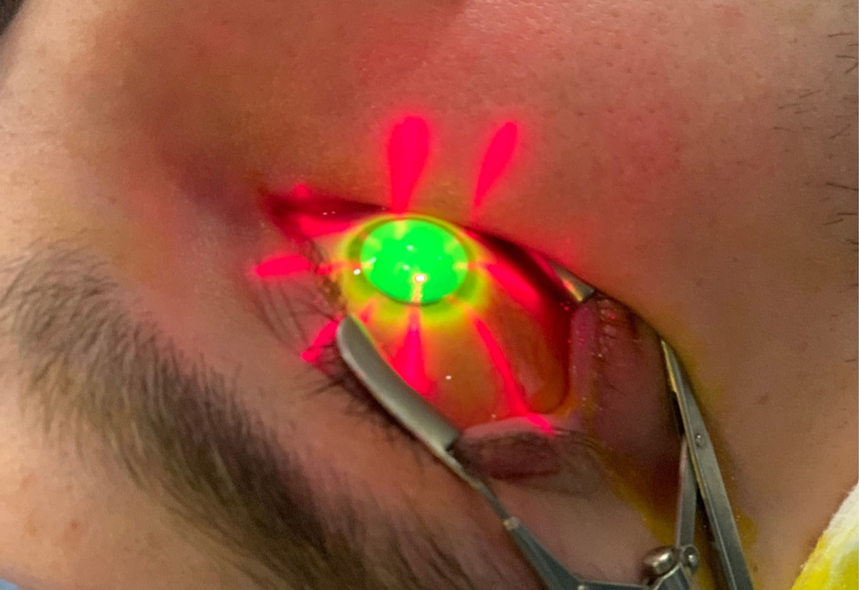 |
|
The increase in CXL and keratoplasty among men in this study aligns with previous findings of men experiencing increased KCN prevalence and severity. Photo: Lily Arendt, OD. Click image to enlarge. |
New research has been published about trends in keratoconus (KCN) treatment patterns over a five-year period (2015-2020) and their correlations with sociodemographic factors. The retrospective study appearing in Ophthalmology included 66,199 patients with a new KCN diagnosis, who were identified in the Academy of Ophthalmology’s Intelligent Research in Sight (IRIS) Registry.
The study authors were able to identify that the percentage of those undergoing collagen crosslinking (CXL) increased from 0.05% in 2015 (prior to its FDA clearance in 2016) to 29.5% in 2020. Average age of KCN patients decreased over the five years, too, going from 44.1 years to 39.2 years. This relatively high age is at odds with that found in prior research, as other studies have indicated mean ages ranging from 17.7 to 28.3 years. “The older age of our cohort compared to prior reports may be explained by limitations of the IRIS Registry;” the researchers wrote in their paper.” it is possible that the practices participating in the IRIS Registry are primarily focused on adult ophthalmologic care, with reduced representation of clinicians focused on pediatric or optometric-run practices where many KCN patients may be managed.”
Despite this difference, the decrease in age over five years still reflects improvements in KCN diagnostics during this time, the authors suggest. Those in the 21 to 40 age bracket were less likely to receive CXL and more likely to receive keratoplasty than those who were 20 or younger, probably due to evidence suggesting KCN patients benefit more from CXL in visual improvement and further visual loss prevention when treated earlier in the disease course.
When comparing CXL vs. no procedure and keratoplasty vs. no procedure, those undergoing CXL were younger and the odds of having CXL done decreased with age. Men were more likely than women to have CXL, while Black patients were less likely than white individuals to have the procedure done and were more likely to have keratoplasty. Hispanic patients had higher likelihood of receiving CXL and keratoplasty compared with non-Hispanic patients. Both procedures varied in prevalence by region and insurance status as well.
In their discussion, the authors explain the sharp increase in CXL was expected since FDA approval of the procedure in 2016. As they elucidate, “with growing evidence of the long-term efficacy of CXL, including data indicating that timely CXL reduces vision loss and decreases the need for keratoplasty by over 50%, an increasing demand for CXL would be expected.” Along with this trend was a drop in percentage of those receiving no treatment, to which they add that “it is likely that more patients with mild or moderate progressive KCN who were previously not advanced enough for keratoplasty are now undergoing CXL, resulting in the observed decline in patients who do not receive any treatment.”
By race, Black patients have increased odds of developing KCN over white patients, also experiencing increased odds of severe vs. mild KCN. This severity may reflect the observation of seeing higher odds of keratoplasty vs. both CXL and no procedure among Black patients. As well, Black patients were less likely to undergo CXL than their white counterparts, potentially because more severe cases may not be amenable to CXL upon presentation. Other social variables are possible, too, like insurance coverage differences and access to cornea specialists.
|
To learn more about the status of CXL, see this feature. |
Finally, those with Medicaid were less likely to undergo CXL and more likely to undergo keratoplasty than those with commercial insurance. This association may be due to reasons of differences in coverage for the CXL procedure or less success in obtaining eyecare appointments compared with private insurance holders.
While there is still room for improvement to be made, the FDA approval of CXL has certainly contributed to a great portion of KCN patients receiving more treatment. The researchers address that “sociodemographic difference in treatment among KCN patients may reflect differences in access, utilization, or care patterns, and future studies should aim to identify strategies to improve access for all patients.”
Syed ZA, Tomaiuolo M, Zhang Q, et al, on behalf of the IRIS Registry Analytic Center Consortium. Trends and sociodemographic patterns in keratoconus management 2015-2020: an American Academy of Ophthalmology IRIS Registry Analysis. Ophthalmology. February 2, 2024. [Epub ahead of print]. |

